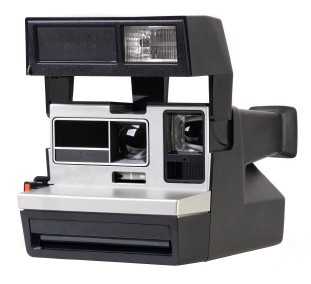There are many things that are behind us, other than 2008. Some are in a constant state of sputtering back to life (see above, excepting Dodos), while others have been wiped from existence forever (see Dodos, above).
Not long ago, I visited a yard sale at the home of some friends. My bargain discovery was a Polaroid Sun 600 camera for three dollars. Three dollars (can you believe it?)!! Such a great deal, if it works. We shall see. I’ve decided that if I can get the camera operating and find some fresh film, then I’ll try my hand at “Polaroid art.” But one step at a time.

This morning I encountered an interesting column in the online New York Times. It seems that a small coterie of enthusiasts is struggling to revive the “dying” Polaroid camera culture, much like the vinyl LP culture has been kept alive by a new generation of music lovers not so easily seduced by the ease of digital technology.
The next few months will end an era that began six decades ago with a contraption called the Model 95 camera. That accordion-style machine delivered instant photography at a price tag equivalent to some $850 today. The SX-70, which spit out color prints, arrived in 1972. American life during the late 20th century had found its Boswell.
The demise of Polaroid’s instant film cameras has been coming for years. Digital technology did it in. The decision this year by the company that Edwin Land founded to stop manufacturing the film has left devotees who grew up with Polaroid’s palm-size white-bordered prints bereft. They have signed up in the thousands as members of SavePolaroid.com. Digital cameras that print instant pictures have materialized to fill the void, providing a practical substitute. But as in most affairs of the heart, logic is beside the point.
Read the entire article by Michael Kimmelman here.
In a search on the ‘net for Polaroid film, I discovered, in an FAQ page, that Polaroid cameras are powered by batteries included in the film cartridge, and not by batteries stowed somewhere in the body of the camera. Fascinating. Now I just need to find some.
On a somewhat related note, we were told as undergraduates at Harvard College that the Science Center complex was constructed to look like a Polaroid camera. It is indeed a known fact that the building’s construction was funded by Edwin Land, who invented the camera. But the story about its intended appearance is, according to online encyclopedia Wikipedia, untrue. However, one look at the building is enough to make wonder.

(photo: The Kidder Smith Images Project)


6 responses so far ↓
1 Brentski // Jan 2, 2009 at 8:19 AM
Hopefully Polaroid film can be likened to the DeLorian DMC-12: Someone somewhere has a warehouse full of them.
2 ABE // Jan 2, 2009 at 3:09 PM
When I heard they were going to quit making the Polaroid film I was really sad!
3 brie // Dec 20, 2009 at 4:01 PM
I was also sad, but now that Christmas is literally around the corner, i can’t think of anything i would rather have. where in the world could i find one?!
4 aro // Oct 15, 2011 at 2:55 AM
I recently attended an auction and acquired three or four polaroid cameras and one package of film. I am curious as to their value? It’s 2011 and you might have already found what you were looking for.
5 santos // Mar 30, 2012 at 9:13 AM
The building was NOT designed to look like a Polaroid camera. It was designed to look like a Land Camera. Edwin Lands first camera creation, which it does. (As much as a building can)
6 santos // Mar 30, 2012 at 9:14 AM
http://fr.m.wikipedia.org/wiki/Fichier:Polaroid_Land_Camera_100_IMGP1930_WP.jpg here is a picture of one.
Leave a Comment